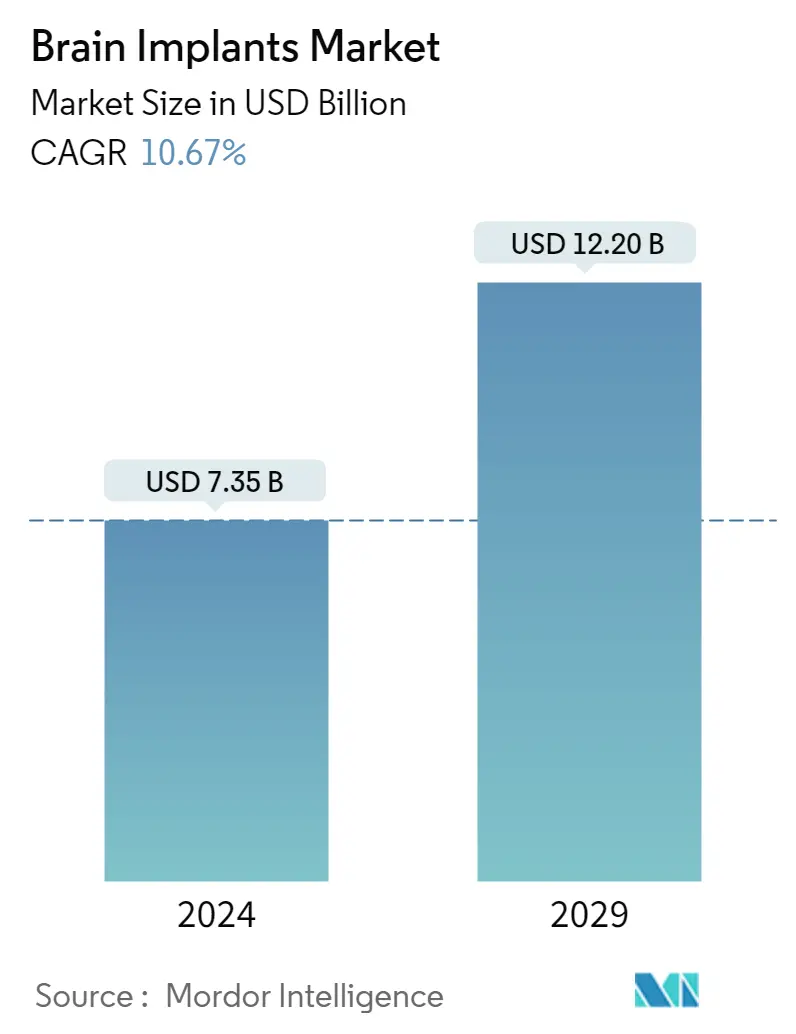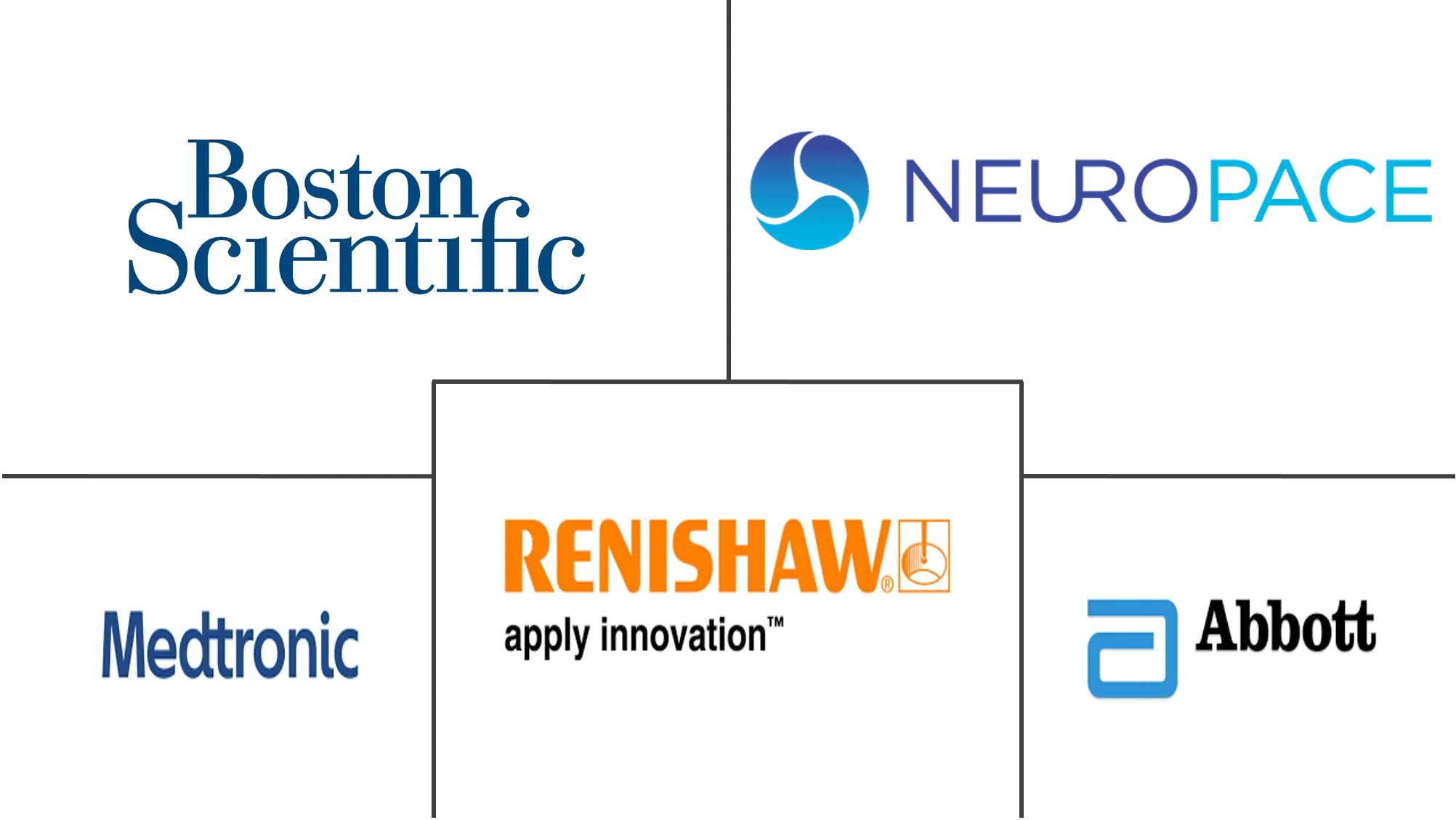Market Size of Brain Implants Industry

| Study Period | 2021 - 2029 |
| Market Size (2024) | USD 7.35 Billion |
| Market Size (2029) | USD 12.20 Billion |
| CAGR (2024 - 2029) | 10.67 % |
| Fastest Growing Market | Asia-Pacific |
| Largest Market | North America |
Major Players
*Disclaimer: Major Players sorted in no particular order |
Brain Implants Market Analysis
The Brain Implants Market size is estimated at USD 7.35 billion in 2024, and is expected to reach USD 12.20 billion by 2029, growing at a CAGR of 10.67% during the forecast period (2024-2029).
The COVID-19 pandemic significantly impacted the growth of the brain implants market globally, due to the suspension and postponement of most elective surgeries and treatments. According to a research article published in medRXiV, 2021, the prevalence of SARS-COV2 viral infection in patients with Parkinson's disease was found to be 11.28%. Further, COVID-19 prevalence in Parkinson's disease patients with deep brain stimulation was found to be 18.18%. Thus, patients suffering from COVID-19 are prone to a high risk of developing neurological disorders during their hospital stays. The strict lockdown restrictions and measures taken to contain the viral transmission increased the chronic stress and burden of neurological disorders. This increased the urgent opening of neurological outpatient services. Thus, the brain implant market was significantly impacted during the pandemic. However, neurological surgeries evolved during the pandemic. For instance, in March 2021, an article published in Springer Nature Limited stated that the neurosurgical community's response to the initial phase of the pandemic, in at least three European countries, maintained high standards of care and low rates of acute mortality. Similarly, another article published in Frontiers Media S.A. in December 2021 stated that the deployment of telemedical services for patients with neurological and psychiatric conditions dramatically escalated as the pandemic evolved. Despite concerns about the format, scheduling, privacy, and reimbursement, the transition was relatively smooth with numerous reports underscoring patient satisfaction. Thus, the normalization of surgeries and the introduction of new methods are expected to increase market growth.
The major factors for the growth of the brain implant market include the rise in the aging population and an increase in the prevalence of neurological disorders and technological advancements in devices. The increase in the number of cases of neurological disorders, such as Alzheimer's, epilepsy, Parkinson's, depression, and essential tremors, is anticipated to propel the demand for brain implants. According to Parkinson's News Today 2021, an estimated 7 to 10 million people worldwide have Parkinson's disease, and approximately 60,000 Americans are diagnosed with this disease, thus, leading to promising growth. Similarly, according to the Parkinson's Foundation 2020, approximately 1.2 million people in the United States are estimated to suffer from Parkinson's disease by 2030. Brain implants are likely to reduce the need for drugs that relieve chronic pain and improve body movement in patients suffering from Parkinson's or any other neurological disease.
The growing geriatric population is also prone to several neurological disorders. According to the World Health Organization (WHO) October 2021 updates, around 1 in 6 people in the world will be aged 60 years or over by 2030, and by 2050, two-thirds of the world's population over 60 years will live in low- and middle-income countries. In such middle income countries the current infrastucture is not capable to provide care and constant monitoring and brain implants could provide that in such regions. Thus, the rising geriatric population, the brain implants market is expected to register significant growth over the forecast period.
Furthermore, collaborations by key market players are expected to increase the market growth as collaborations provide synergy of research and devlopment and required investment which increases the success rate of the program. For instance, in April 2022, a collaborative project between Queensland Brain Institute (QBI) together with Neurosciences Queensland and Abbott Neuromodulation developed a remote care platform that uses wireless technology in brain implant technology to allow patients to access treatment from anywhere in the world. This new technology will link to developing brain-reading devices, such as implants in the brain. Thus, the abovementioned factors such as the increasing prevalence of neurological disorders and collaborations are expected to increase market growth over the forecast period. However, the high cost of devices and low adoption rates in developing and underdeveloped regions are expected to hinder the market growth.
Brain Implants Industry Segmentation
As per the scope of the report, brain implants also referred to as neural implants are devices that are used to stimulate certain parts of the brain to stimulate senses, improve physical function, and enhance memory. The Brain Implants Market is Segmented by Product Type (Deep Brain Stimulator, Spinal Cord Stimulator, and Vagus Nerve Stimulator), Application (Chronic Pain, Epilepsy, Parkinson's Disease, Depression, Essential Tremor, Alzheimer's Disease, and Other Applications), and Geography (North America, Europe, Asia-Pacific, Middle East and Africa, and South America). The market report also covers the estimated market sizes and trends for 17 different countries across major regions, globally. The report offers the value (in USD million) for the above segments.
| By Product Type | |
| Deep Brain Stimulator | |
| Spinal Cord Stimulator | |
| Vagus Nerve Stimulator |
| By Application | |
| Chronic Pain | |
| Epilepsy | |
| Parkinson's Disease | |
| Depression | |
| Essential Tremor | |
| Alzheimer's Disease | |
| Other Applications |
| Geography | ||||||||
| ||||||||
| ||||||||
| ||||||||
| ||||||||
|
Brain Implants Market Size Summary
The brain implants market is poised for substantial growth over the forecast period, driven by an aging population, the rising prevalence of neurological disorders, and technological advancements in implant devices. The market experienced a significant impact during the COVID-19 pandemic, which led to the postponement of elective surgeries and treatments. However, the pandemic also spurred innovations in neurosurgical practices and the adoption of telemedical services, which are expected to contribute to market expansion. The increasing incidence of conditions such as Alzheimer's, Parkinson's, and epilepsy is anticipated to boost demand for brain implants, as these devices offer potential alternatives to traditional drug therapies. The growing geriatric population, particularly in low- and middle-income countries, further underscores the need for brain implants to manage neurological disorders effectively.
North America is expected to maintain a significant share of the brain implants market, supported by high healthcare standards and favorable policies that enhance accessibility and affordability. The region's market growth is bolstered by the increasing prevalence of neurological disorders and the approval of new brain implant technologies. Collaborations among key market players, such as those between research institutions and companies, are fostering innovation and expanding the reach of brain implant technologies. Despite challenges like high device costs and low adoption rates in some regions, the market is expected to grow steadily, driven by ongoing research, investment in Alzheimer's disease initiatives, and advancements in brain-machine interface technologies.
Brain Implants Market Size - Table of Contents
-
1. MARKET DYNAMICS
-
1.1 Market Overview
-
1.2 Market Drivers
-
1.2.1 Rise in Aging Population and Increase in Prevalence of Neurological Disorders
-
1.2.2 Technological Advancements in Devices
-
-
1.3 Market Restraints
-
1.3.1 High Cost of Devices
-
1.3.2 Low Adoption Rates in Developing and Underdeveloped Regions
-
-
1.4 Porter's Five Force Analysis
-
1.4.1 Threat of New Entrants
-
1.4.2 Bargaining Power of Buyers/Consumers
-
1.4.3 Bargaining Power of Suppliers
-
1.4.4 Threat of Substitute Products
-
1.4.5 Intensity of Competitive Rivalry
-
-
-
2. MARKET SEGMENTATION (Market Size by Value - USD million)
-
2.1 By Product Type
-
2.1.1 Deep Brain Stimulator
-
2.1.2 Spinal Cord Stimulator
-
2.1.3 Vagus Nerve Stimulator
-
-
2.2 By Application
-
2.2.1 Chronic Pain
-
2.2.2 Epilepsy
-
2.2.3 Parkinson's Disease
-
2.2.4 Depression
-
2.2.5 Essential Tremor
-
2.2.6 Alzheimer's Disease
-
2.2.7 Other Applications
-
-
2.3 Geography
-
2.3.1 North America
-
2.3.1.1 United States
-
2.3.1.2 Canada
-
2.3.1.3 Mexico
-
-
2.3.2 Europe
-
2.3.2.1 Germany
-
2.3.2.2 United Kingdom
-
2.3.2.3 France
-
2.3.2.4 Italy
-
2.3.2.5 Spain
-
2.3.2.6 Rest of Europe
-
-
2.3.3 Asia-Pacific
-
2.3.3.1 China
-
2.3.3.2 Japan
-
2.3.3.3 India
-
2.3.3.4 Australia
-
2.3.3.5 South Korea
-
2.3.3.6 Rest of Asia-Pacific
-
-
2.3.4 Middle East and Africa
-
2.3.4.1 GCC
-
2.3.4.2 South Africa
-
2.3.4.3 Rest of Middle East and Africa
-
-
2.3.5 South America
-
2.3.5.1 Brazil
-
2.3.5.2 Argentina
-
2.3.5.3 Rest of South America
-
-
-
Brain Implants Market Size FAQs
How big is the Brain Implants Market?
The Brain Implants Market size is expected to reach USD 7.35 billion in 2024 and grow at a CAGR of 10.67% to reach USD 12.20 billion by 2029.
What is the current Brain Implants Market size?
In 2024, the Brain Implants Market size is expected to reach USD 7.35 billion.

